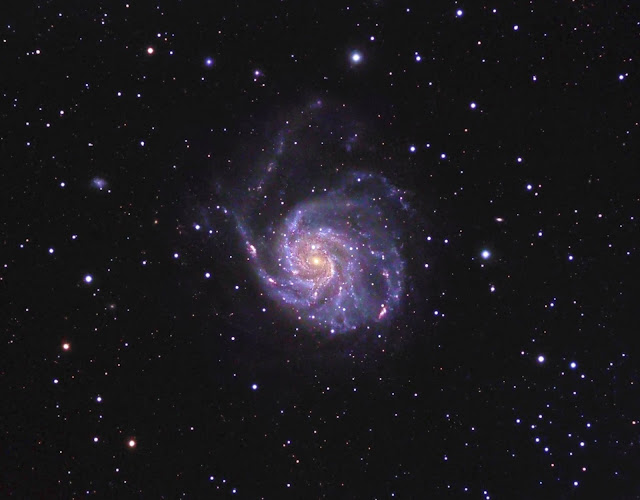 |
| NGC 4656-7 and NGC 4631 |
Objects: NGC 4656-7 (the Hockey Stick galaxy) and NGC 4631 (the Whale galaxy)
Type: Barred Spiral Galaxies (NGC 4656-7 morphological classification SB(s)m pec), NGC 4631 SB(s)d
Constellation: Canes Venatici
Distance: 30 million light years
Date: March 26th, 2020
Equipment: ATIK 460EX with EFW2, Skywatcher f5.5 Esprit 100 ED refractor, Avalon Linear mount, guiding with Lodestar X2/PHD
Subframes: 10 x 600s luminance, 6 x 300s (2x2 binned) each for RGB, flats, bias as darks (hot pixel removal in Astroart). Above is an 80% crop of the original image.Equipment: ATIK 460EX with EFW2, Skywatcher f5.5 Esprit 100 ED refractor, Avalon Linear mount, guiding with Lodestar X2/PHD
As the winter turns to spring, so the night sky turns from a host of local galactic nebulae to the dim and chillingly distant realm of faraway galaxies. The pair of interacting galaxies pictured above can be found in the obscure constellation of Canes Venatici, tucked away beneath the handle of the Plough (see map below).
 |
| Field of NGC 4656-7 and NGC 4631 |
Discovered on March 20th. 1787 by William Herschel, the Hockey Stick was classified as two separate nebulae, long before their true identities as a single remote galaxy was known. NGC 4656, the blade of the hockey stick, is a bright starburst region, originally observed as a separate entity from the main body of the galaxy, NGC 4657.
The eagle-eyed Herschel discovered NGC 4631 on the same evening. We see this galaxy inclined only 5 degrees from edge on. Radial velocity data suggests that if we were able to see this object from above, it would be a late-type barred spiral with very clumpy and loosely-wound arms. Its gravitational interactions with NGC 4656 and the small satellite galaxy lying just above it (NGC 4627) have triggered a wave of star formation within NGC 4631 giving rise to its mottled appearance, with bright starburst regions standing out from surrounding galactic dust clouds.
 |
| NGC designations for the NGC 4631 group |
The evening of March 26th was blighted by air pollution, despite the whole country being on coronavirus shut-down (plus side: no aircraft trails!) resulting in rather poor backgrounds a and noisy subframes. I also had some problems with the Avalon mount, which seemed to be "twitching" in RA, though it didn't seem to degrade image quality too much.
I have tightened up the RA clutch and I hope that problem has gone away!





